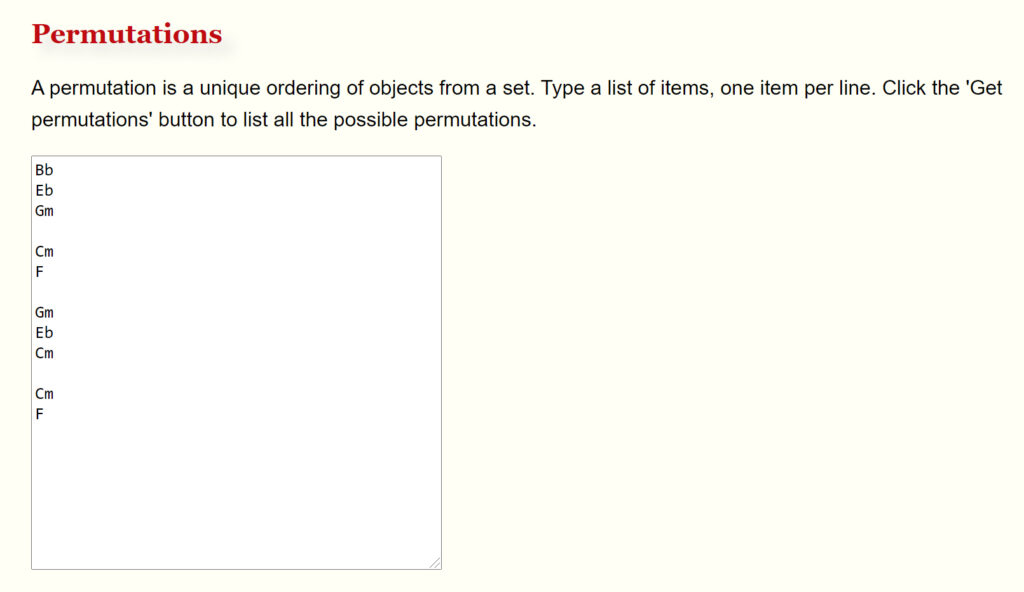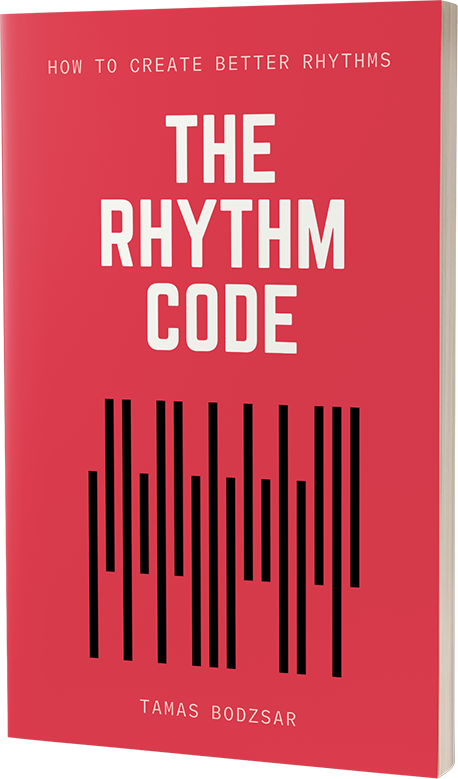
I got another question from one of our readers: “how to harmonize a melody?“
To be honest, I’m not 100% sure what exactly he meant by this question, because it can mean two different things.
1. You have a melody and you want to find a matching chord progression. (This is the topic of songwriting.)
2. You have a melody AND you also have the chords, and you want to add more voices to create a 3 or 4-part melody, something like you create for a choir or an acapella group, maybe for backing vocals. (This is the topic of arranging.)
In this article, I will answer the first question, but there will be another post soon, which will answer the second question too!
How to find chords for a melody
Let’s say you have a melody and you want to find the right chords for it. A melody can be harmonized in many different ways, with very different end results.
So let’s pick a melody, and try to find the chords for it.

I created this random melody just for the purpose of the demonstration.
The first thing you need to do is finding the key. For that, let’s put the melody notes in ascending order so we get the scale:

This melody only uses 6 notes, so it’s not enough to determine the key, but we already know that the key can be either Bb major (G minor) or F major (D minor).
Now write down all the possible chords for each key. Let’s assume that this is not a jazz song, so we don’t want to use the “VII” diminished chords.
In the key of Bb major:
Bb – Cm – Dm – Eb – F – Gm
In the key of F major:
F – Gm – Am – Bb – C – Dm
Melodies usually use a chord tone at the beginning of the bars. Or if there are two chords in a bar, there is a chord tone at the “one” and at the “three”.
But there is one thing that makes this a little bit complicated: rhythm. Because of rhythm, sometimes melody notes are anticipated. (I explain this in more detail in the Songwriting Essentials course.)
So let’s mark the possible chord tones with red color:

Next, we write down all the possibilities for each chord.
The first chord tone is Bb, so these are our options if this is in the key of Bb major:
Bb, Eb, Gm
And these are the possible chords if this is in the key of F major.
Bb, Gm
The next chord tone is C, so the possible chords in the key of Bb major are:
Cm, F
In the key of F major:
Am, F, C
The next chord tone is G, so the possible chords in the key of Bb major are:
Gm, Eb, Cm
In the key of F major:
Cm, Gm
The last chord tone is C, but we already know the possible chords for that note.
Now we need to combine ALL these possibilities, but since there are a lot of combinations, we will use a calculator like this.
Here is how I put the chords into the calculator:

So you put the possible chords for the first note below each other, and then leave one line empty, then put the possible chords for the next note below each other, and so on.
Then click on the button “Generate combinations”. The results: 36 possible chord progressions:
- Bb, Cm, Gm, Cm
- Bb, Cm, Gm, F
- Bb, Cm, Eb, Cm
- Bb, Cm, Eb, F
- Bb, Cm, Cm, Cm
- Bb, Cm, Cm, F
- Bb, F, Gm, Cm
- Bb, F, Gm, F
- Bb, F, Eb, Cm
- Bb, F, Eb, F
- Bb, F, Cm, Cm
- Bb, F, Cm, F
- Eb, Cm, Gm, Cm
- Eb, Cm, Gm, F
- Eb, Cm, Eb, Cm
- Eb, Cm, Eb, F
- Eb, Cm, Cm, Cm
- Eb, Cm, Cm, F
- Eb, F, Gm, Cm
- Eb, F, Gm, F
- Eb, F, Eb, Cm
- Eb, F, Eb, F
- Eb, F, Cm, Cm
- Eb, F, Cm, F
- Gm, Cm, Gm, Cm
- Gm, Cm, Gm, F
- Gm, Cm, Eb, Cm
- Gm, Cm, Eb, F
- Gm, Cm, Cm, Cm
- Gm, Cm, Cm, F
- Gm, F, Gm, Cm
- Gm, F, Gm, F
- Gm, F, Eb, Cm
- Gm, F, Eb, F
- Gm, F, Cm, Cm
- Gm, F, Cm, F
Now play these chord progressions and sing the melody over them! You will hear which chord progression is the best for the melody. The secret of good songwriting is in the selection. You need to be able to select the best idea from many ideas.
But you don’t necessarily need to use four chords. And not all those selected melody notes should be chord tones either!
Personally, I prefer this chord progression for this melody:

Also, notice that the melody notes on the second chord change are C – A – F, and this suggests that it is most likely an F chord.
Let’s see the chord combinations in the key of F major. The calculator gives me 36 possible chord progressions again:
- Bb, Am, Cm, Am
- Bb, Am, Cm, F
- Bb, Am, Cm, C
- Bb, Am, Gm, Am
- Bb, Am, Gm, F
- Bb, Am, Gm, C
- Bb, F, Cm, Am
- Bb, F, Cm, F
- Bb, F, Cm, C
- Bb, F, Gm, Am
- Bb, F, Gm, F
- Bb, F, Gm, C
- Bb, C, Cm, Am
- Bb, C, Cm, F
- Bb, C, Cm, C
- Bb, C, Gm, Am
- Bb, C, Gm, F
- Bb, C, Gm, C
- Gm, Am, Cm, Am
- Gm, Am, Cm, F
- Gm, Am, Cm, C
- Gm, Am, Gm, Am
- Gm, Am, Gm, F
- Gm, Am, Gm, C
- Gm, F, Cm, Am
- Gm, F, Cm, F
- Gm, F, Cm, C
- Gm, F, Gm, Am
- Gm, F, Gm, F
- Gm, F, Gm, C
- Gm, C, Cm, Am
- Gm, C, Cm, F
- Gm, C, Cm, C
- Gm, C, Gm, Am
- Gm, C, Gm, F
- Gm, C, Gm, C
The moment you start to play these chords, you realize that this melody is probably NOT in the key of F major! However, I found ONE combination that sounds good:

But these chords can come from both F major and Bb major keys! In fact, it totally feels like Bb major: VIm – V – II – II. The chord “II” (C) sounds like a borrowed chord. (And no, it doesn’t make the song Lydian!)
Do you know why this melody sounds more like it’s in the key of Bb major? Because the last motif (C – Bb – G – F) is almost a complete pentatonic scale. And it’s a Bb pentatonic, which obviously sounds better in the key of Bb major.
But the selected melody notes (on the “one” and on the “three”) don’t always need to be chord tones!
So let’s experiment with other chords. Now we are sure that this song is in the key of Bb major. So here are the possible chords again:
Bb – Cm – Dm – Eb – F – Gm
The only chord I didn’t test is Dm. What if I use it for the second chord? I really like this version too: Bb – Dm – Eb – Eb
We only tried diatonic chords for this melody. But you can create more unique chord progressions for your songs if you use non-diatonic chords.
For example, check out this chord progression from the chorus of “Too Young To Die” by Jamiroquai:
Cm7 – Dbm7 – Abm7 – Bbm7
He always uses these very unique and crazy chord progressions in his songs, and in the Songwriting Essentials course I give you the formula for these kinds of unique chord progressions.
Other things to consider
In this example, I have shown you how to harmonize a melody for only two bars. But you can go through a complete song with this method. However, you shouldn’t use the combination calculator for a complete song, because that would generate a million possible combinations!
Keep in mind that there are repetitions in the chord progression in most songs. But if you already have the melody for the whole song, that would determine what chords you can use for the whole song! (Though it’s always an option to change the melody if you are not happy with the results.)
Here are just two simple examples of song structures.
1. You can use the same four chords in the whole song. For example:
verse:
Bb – F – Eb – Eb
Bb – F – Eb – Eb
Bb – F – Eb – Eb
Bb – F – Eb – Eb
chorus:
Bb – F – Eb – Eb
Bb – F – Eb – Eb
Bb – F – Eb – Eb
Bb – F – Eb – Eb
2. You can use the same four chords for the verse, and a different chord progression for the chorus. For example:
verse:
Bb – F – Eb – Eb
Bb – F – Eb – Eb
Bb – F – Eb – Eb
Bb – F – Eb – Eb
chorus:
Bb – Eb – F – F
Bb – Eb – F – F
Bb – Eb – F – F
Bb – Eb – F – F
In the end, your chord progression should make sense on its own, without the melody! So always listen to your chord progression without the melody. I recommend playing the chord progression with a guitar or with a piano (or put it in a DAW if you don’t use any instruments), and record it, so you can listen to it.
Think about what is the tempo of your song. Is this a fast song or a slow song? Faster songs usually have fewer chords in them, or they have slower “chord change speed”. For example, you can use a new chord in every bar if the song is slower, but you can use a new chord every two bars if the song is faster.
In Summary
1. Write your melody notes in ascending order, so you get all the notes, which helps you find the scale.
2. Write down all the possible chords in the key. You will probably not use the VII (diminished) diminished chord unless it’s a “jazzy” song.
3. Look for the pentatonic scale, which helps you determine the key.
4. Identify the possible chord tones at the chord changes. (For example, the first notes of the bars.)
5. Write down the possible chords for each place, and combine all of them with a “combination calculator”.
6. Try to experiment with other chords in the key.
7. Learn from successful songs to create more unique chord progressions, using the Songwriting Essentials course.
The secret pattern behind successful songs
Get the eBook for $4.99

